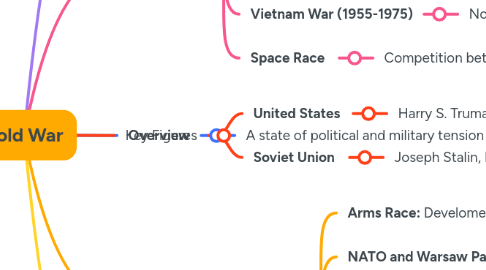
1. **Overview**
1.1. A state of political and military tension after World War II between powers in the Western Bloc (the US, NATO, and their allies) and powers in the Eastern Bloc (the Soviet Union and its satellite states).
1.1.1. **Time Period: 1947 - 1991**
2. Major Ideologies
2.1. **Capitalism**
2.1.1. Led by the United States
2.2. **Communism**
2.2.1. Led by the Soviet Union
3. Key Events
3.1. **Berlin Blockade (1948-1949)**
3.1.1. Soviet blocking of Berlin from allies, resulted in the Berlin Airlift.
3.2. **Korean War (1950-1953)**
3.2.1. North Korea (supported by China and the USSR) vs. South Korea (supported by the UN, primarily the USA).
3.3. **Cuban Missile Crisis (1962)**
3.3.1. 13-day confrontation between the United Stated and the Soviet Union concerning American ballistic missile deployment in Italy and Turkey with consequent Soviet ballistic missile deployment in Cuba.
3.4. **Vietnam War (1955-1975)**
3.4.1. North Vietnam (supported by the USSR, China, and other communist allies) vs. South Vietnam (supported by the United States and other anti-communist allies).
3.5. **Space Race**
3.5.1. Competition between USSR and USA to achieve significant milestones on space exploration.
4. Key Figures
4.1. **United States**
4.1.1. Harry S. Truman, Dwight D. Eisenhower, John F. Kennedy, Ronald Reagan.
4.2. **Soviet Union**
4.2.1. Joseph Stalin, Nikita Khrushchev, Leonid Brezhnev, Mikhail Gorbachev
